ELIMINATION of a paediatric brain tumour called diffuse intrinsic pontine glioma (DIPG) has successfully taken place in a mouse model through the injection of engineered CAR-T cells. The research, from Stanford University, California, USA, could provide the basis for new treatments for the condition that affects school-age children, and which currently has no cure.
Undetectable Tumours
Following screening of human DIPG tumour cultures, the team discovered to their surprise that a sugar molecule, GD2, was abundant on the surface of tumours in 80% of cases. After successfully destroying DIPG cell cultures that carry the H3K27M mutation, which drives both excess expression of GD2 and the development of the majority of DIPG tumours, in a dish, the technique was tested in mice whose brainstem was implanted with human DIPG tumours. The mice either received one intravenous injection of GD2 CAR-T cells or a CAR-T cell injection that react to a different target as a control 7–8 weeks after the tumour was first established. While the mice receiving the control had no tumour regression, the tumours in mice treated with GD2 CAR-T cells were undetectable after 14 days.
Therapeutic Potential
The brains of the mice were then examined after 50 days, with immunostaining revealing that each control mouse had tens of thousands of cancer cells remaining in contrast to the mice treated with GD2 CAR-T cells, each of whom only had a few dozen cells left. In these residual remaining cells there was no expression of GD2, suggesting these cells were not vulnerable to the immune therapy. This means that the immune therapy would probably have to be used in combination with other treatments to eradicate all the tumour cells and thus prevent the cancer reoccurring.
“I don’t think one strategy is going to cure this extremely aggressive and deadly cancer,” commented senior author Dr Michelle Monje, Stanford University. “However, I think CAR-T cell immunotherapy is part of the puzzle of DIPG treatment in a way that I am quite hopeful about.”
Next Step
The next stage is to test the technique on humans; however, the authors acknowledge that safeguards need to be put in place first to minimise the risk of side effects that occurred in some of the mice in this study, such as dangerous levels of brain swelling.
James Coker, Reporter
For the source and further information about the study, click here.








